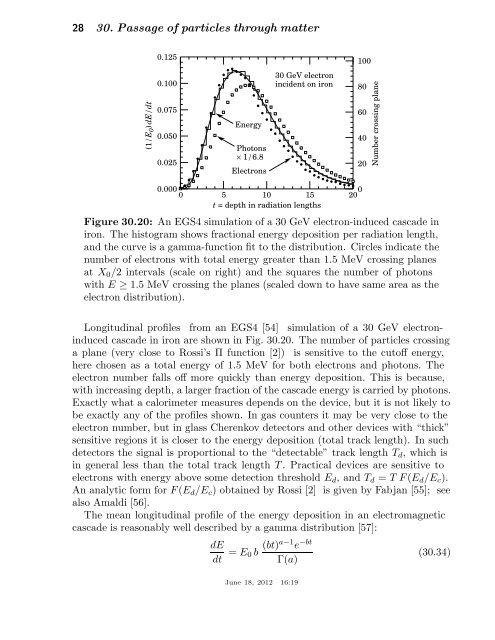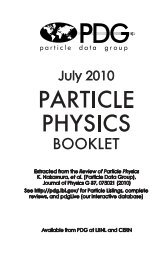30. Passage of particles through matter 1 - Particle Data Group
30. Passage of particles through matter 1 - Particle Data Group
30. Passage of particles through matter 1 - Particle Data Group
Create successful ePaper yourself
Turn your PDF publications into a flip-book with our unique Google optimized e-Paper software.
28 <strong>30.</strong> <strong>Passage</strong> <strong>of</strong> <strong>particles</strong> <strong>through</strong> <strong>matter</strong><br />
(1/E 0 )dE/dt<br />
0.125<br />
0.100<br />
0.075<br />
0.050<br />
0.025<br />
Energy<br />
Photons<br />
× 1/6.8<br />
Electrons<br />
30 GeV electron<br />
incident on iron<br />
0.000<br />
0 5 10 15<br />
0<br />
20<br />
t = depth in radiation lengths<br />
Figure <strong>30.</strong>20: An EGS4 simulation <strong>of</strong> a 30 GeV electron-induced cascade in<br />
iron. The histogram shows fractional energy deposition per radiation length,<br />
and the curve is a gamma-function fit to the distribution. Circles indicate the<br />
number <strong>of</strong> electrons with total energy greater than 1.5 MeV crossing planes<br />
at X0/2 intervals (scale on right) and the squares the number <strong>of</strong> photons<br />
with E ≥ 1.5 MeV crossing the planes (scaled down to have same area as the<br />
electron distribution).<br />
Longitudinal pr<strong>of</strong>iles from an EGS4 [54] simulation <strong>of</strong> a 30 GeV electroninduced<br />
cascade in iron are shown in Fig. <strong>30.</strong>20. The number <strong>of</strong> <strong>particles</strong> crossing<br />
a plane (very close to Rossi’s Π function [2]) is sensitive to the cut<strong>of</strong>f energy,<br />
here chosen as a total energy <strong>of</strong> 1.5 MeV for both electrons and photons. The<br />
electron number falls <strong>of</strong>f more quickly than energy deposition. This is because,<br />
with increasing depth, a larger fraction <strong>of</strong> the cascade energy is carried by photons.<br />
Exactly what a calorimeter measures depends on the device, but it is not likely to<br />
be exactly any <strong>of</strong> the pr<strong>of</strong>iles shown. In gas counters it may be very close to the<br />
electron number, but in glass Cherenkov detectors and other devices with “thick”<br />
sensitive regions it is closer to the energy deposition (total track length). In such<br />
detectors the signal is proportional to the “detectable” track length Td, which is<br />
in general less than the total track length T. Practical devices are sensitive to<br />
electrons with energy above some detection threshold Ed, and Td = T F(Ed/Ec).<br />
An analytic form for F(Ed/Ec) obtained by Rossi [2] is given by Fabjan [55]; see<br />
also Amaldi [56].<br />
The mean longitudinal pr<strong>of</strong>ile <strong>of</strong> the energy deposition in an electromagnetic<br />
cascade is reasonably well described by a gamma distribution [57]:<br />
dE<br />
dt = E0 b (bt)a−1e−bt Γ(a)<br />
June 18, 2012 16:19<br />
100<br />
80<br />
60<br />
40<br />
20<br />
Number crossing plane<br />
(<strong>30.</strong>34)







